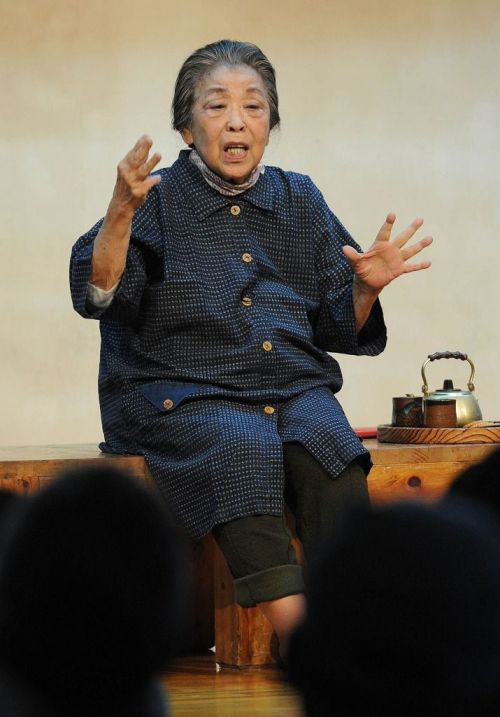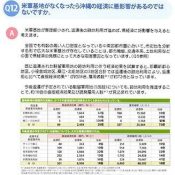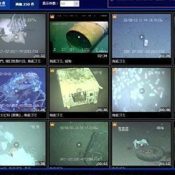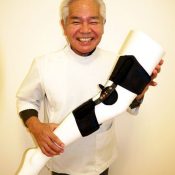April 11, 2017 Ryukyu Shimpo
The Liberal Democratic Party of Okinawa (Okinawa LDP) held its 48th annual convention and solidified its policy of “accepting” the relocation of U.S. Marine Corps Air Station (MCAS) Futenma to Henoko, Nago City. This represents a shift away from its previous position of “pursuing every possibility, including relocation to Henoko.”
However, does the pride of Okinawan conservatives not rest on convincing the government and LDP headquarters to push the Abe administration, which refuses to change its position that “Henoko is the only option”, to instead investigate “every possibility”? The Okinawa LDP at one point campaigned on the promise to push for Futenma to be relocated outside of Okinawa, and must be held accountable.
At the convention, the party announced, “We can conceive of no concrete and realistic policy other than to accept the relocation [of Futenma] to a replacement facility in Henoko in accordance with the Supreme Court’s ruling.”
On what grounds do they allege that accepting the Henoko plan is “realistic”? Last month, a private think tank compiled an advisory report proposing an alternative to the Henoko plan. The report offers a paradigm shift, suggesting that rather than search for a “location” to serve as a replacement for MCAS Futenma, a solution can be found by modifying the operations of the U.S. military itself. Has the Okinawa LDP investigated their proposal?
The Okinawa LDP went on to criticize the governor, saying, “There is no prospect of realizing the cessation of operations [at MCAS Futenma] within five years, and it is all because of Governor Onaga’s lack of cooperation.” Such a remark does nothing but echo the prime minister’s comments.
In February of this year, Prime Minister Shinzo Abe stated that cessation of operations at Futenma within five years, something he had promised himself, was unfeasible, saying, “Governor Takeshi Onaga is not cooperating with us. It is a difficult situation.”
The prime minister made the aforementioned promise to then-Governor Hirokazu Nakaima and solidified it with a cabinet resolution to “make every effort”, then abandoned his promise without putting in any effort and attempted to shift the blame to Governor Onaga. From the start, it was merely an empty promise fabricated to get the former governor to agree to the Henoko land reclamation.
In his opening remarks at the convention, Okinawa LDP leader Moriyuki Teruya compared the national government to a “parent” with Okinawa as its “child” and criticized the Onaga administration, saying, “The child is unilaterally criticizing its parent, the government, and causing conflict.” However, after Japan’s laws were amended to decentralize power, the national government and regional governments were put on equal footing, and it is therefore inappropriate to compare their relationship to the hierarchical relationship of a parent and child.
At the prefectural assembly, Governor Onaga has stated that being an Okinawan conservative means “understanding the necessity of national security while questioning injustice that cannot be tolerated.” In the 1960s, when the mainstream LDP was unable to go against the authoritarian rule of High Commissioner Caraway and upheld the status quo, Naha Mayor Junji Nishime and other reformists defected from the LDP, seeking increased right to self-governance.
By using the word “realistic”, thereby deferring to and becoming indistinguishable from the Abe administration, the Okinawa LDP is deviating from the tradition of Okinawan conservatives.
(English translation by T&CT and Sandi Aritza)
Go to Japanese

April 10, 2017 by Ryukyu Shimpo
Sumiko Kitajima (born Sumiko Machida), the actress who was famous for her one-woman play that spread the message of the importance of peace using the Battle of Okinawa and post-war history as material, passed away from renal cell cancer at a hospital in Naha at 7:10 p.m. on April 9. She was 85.
Kitajima was born in 1931 in Motobu-cho. Her father, the actor Shosei Uema, had experienced war while on tour in Palau. After graduating high school, Kitajima was steered towards acting by her father. She extended her range of expression by appearing in Anthropology Hall (written by Seishin Chinen) with the acting troupe Sozo.
In 1979, she performed the one-woman play Island Ballad (written by Keifuku Janamoto), after which she began creating her own works. She also served as a personality on the long-running program “Minyode chu uganabira” on RBCi radio from 1963 through 2016. Also, almost every year starting in 2001, she appeared as an actress in Children’s Day Performance at the Sakima Art Museum.
In 1981 Kitajima was awarded the Agency for Cultural Affairs Arts

Sumiko Kitajima performing the one-woman play Akai bukubuku- on June 9, 2013 Okinawa University in Naha
Festival Excellence Award for Theatre. In ‘89 she won the Okinawa Times’ Prize for the Arts. In ’96 she won the Yasue Yamamoto Award, and was recognized by Okinawa as a Person of Cultural Merits. In ’99 she was recognized as a keeper of Okinawan intangible cultural assets for “Ryukyu lyric drama.” In 2006 she was awarded the Ryukyu Shimpo award. She was selected as an Okinawan person of merit in 2012. In 2016 she was awarded The Order of the Rising Sun, Gold and Silver Rays.
Naohiko Uehara, who worked as a personality with Kitajima for many years on Minyode says, “After working together for more than 50 years, she is just like a sister to me. She had a fantastic personality, and kept an intense pace. I’m sure there were things she still wanted to do. Today I can say is, “Thank you for your efforts,” with a pale face. The best memorial we can give her is to continue on, “the things she left behind.”
(Translated by T&CT and Sam Grieb)
Go to Japanese

April 12, 2017 Ryukyu Shimpo
[Okinawa] This past March, the City History Editorial Officers of Okinawa City established “Web Histreet,” the Okinawa City Postwar Data Digital Archive, a website that promotes various resources regarding the city’s postwar history. The site enables people to search for news articles regarding topics they are interested in. People can then view the printed article on one of the kiosks located in “Histreet,” the City Postwar Cultural Gallery located in Chuo, Okinawa City. Currently, the website holds several hundred thousand articles from Ryukyu Shimpo and Okinawa Times, which will continue to grow. The hope is for people to make use of this resource when researching Okinawa’s postwar history and to attract more people to the gallery.
Establishing the website was a part of a 2016 project for the city called, “Postwar Cultural Gallery Project.” The website was funded by a one-time grant and is available in Japanese, English, Korean, and Chinese (traditional and simplified) languages. The website also promotes information on exhibitions currently being held at the gallery, along with resources published by the City History Editorial Officers.
The website holds a large amount of old newspaper articles. For example, articles from Ryukyu Shimpo’s predecessor, Uruma Shimpo. It also carries articles from Chubu Information and Chubu Daily, which circulated throughout the central part of the Okinawa Main Island between the mid-1950s to the early 1960s. People are able to search by keyword(s) or from a chronological table. A list of related articles and their headlines will display after clicking the search button. Additionally, there about 100 video clips.
The search function can be used anywhere as long as there is Internet access. However, viewing the printed articles and video footage, along with printing can only be done from one of the four kiosks located in the main Histreet building. Additionally, printing requires an application to the city, and depending on the article, some cannot be printed.
Project General Manager Genta Maeshiro explained, “A large amount of government documents under the U.S. occupation were destroyed. In order to understand the situation of back then, (we) began collecting newspaper articles.” He then said, “(We) would like people to learn more about the city’s history” and urged people to utilize the website.
(English translation by T&CT and Chelsea Ashimine)
Go to Japanese

April 11, 2017 Ryukyu Shimpo
On April 10, the Okinawa prefectural government (OPG) finished producing question-and-answer format pamphlets presenting the problems at hand with U.S. military base issues in a way that is simple and easy-to-understand. Examples of misinformation and baseless allegations regarding Okinawa have been seen here and there, which is keeping resolutions to base issues at bay. The goal of the 40,000 pamphlets is to provide correct information. Most will be sent to schools and private businesses in Okinawa, but the remaining 1,700 will be distributed in cities, towns and villages throughout Japan.
These pamphlets answer questions including the following: Weren’t U.S. military bases built on empty plots, and don’t people live in the vicinity? Isn’t Okinawa’s economy largely dependent on U.S. bases? Wouldn’t revising the U.S.-Japan Status of Forces Agreement be troublesome?
In addition the pamphlets explain Okinawa’s state of affairs using statistics and pictures related to Okinawa’s history, the layout of prewar villages, Okinawa’s economic climate, and the current status of U.S. military stationing agreements in other countries.
The Oura Bay site in Nago planned for Futenma Air Station’s replacement facility is home to 5,800 species of animals and plants including 262 endangered species. These numbers are comparable to those of Japan’s World Natural Heritage sites. The pamphlets include photographs of these species and the coral reef.
Head of the Executive Office of the Okinawa Governor Kiichiro Jahana said, “Currently there are many misunderstandings in regards to Okinawa’s base issues, including among young people in Okinawa.” He hopes people across Japan will understand the truth regarding the formation and history of bases in Okinawa, and that this understanding may lead base issues to be resolved.
(English translation by T&CT and Erin Jones)
Go to Japanese

April 10, 2017 Ryukyu Shimpo
On the morning of April 10, the Okinawa Defense Bureau (ODB) conducted maritime work towards construction of a new U.S. base in Henoko, Nago, which is part of the plan to move the U.S. Marine Corp Air Station Futenma in Ginowan.
In front of the gate of Camp Schwab, about 50 people staged a sit-in protest to block materials for the construction from being brought into the base.
One of them held a placard reading: “Money is temporary but sorrow continues for 200 years,” while another holding a newspaper article on the U.S. missile attacks against Syria protested in English: “Why does the United States destroy other countries?”
At 9:00 a.m., the riot police forcibly removed sit-in protesters as vehicles carrying construction materials arrived at Camp Schwab.
About 30 vehicles, including dump trucks carrying crushed stones and sediments and concrete mixer trucks, entered the base.
At 11 a.m., the scene was chaotic for a while with protestors gathering in front of the gate to block the construction vehicles and U.S. military vehicles.
At sea, as of 10:00 a.m., work on spreading floats towards Sedake beach was confirmed to have taken place. Following this work, the ODB will likely install pollution prevention membranes.
(English translation by T&CT)
Go to Japanese

April 4, 2017 Ryukyu Shimpo
The International Ocean Environment Information Center (GODAC) located in Toyohara, Nago, released on April 3 a database including images and footage of deep-sea garbage (debris) in Japan’s exclusive economic zone (EEZ) on its internet site.
The GODAC says, “We would like everyone to make use of it for education for the environmental protection.”
The GODAC extracted garbage data from images and videos taken by the Japan Ocean Research and Development Organization (JAMSTEC)’s survey vessels and vehicles including submersibles, and classified the data by place and the type of garbage.
Six hundred and eighty of the 1672 images and videos are published. There are dozens of garbage images and videos found in the water near Okinawa.
Various types of garbage can be observed in the deep sea such as sandals at a depth of 713 meters in the Okinawa Trough and the head of a mannequin at the depth of 6280 meters in the Japan Trench.
The GODAC’s database is http://www.godac.jamstec.go.jp/catalog/dsdebris/j/index.html
(English translation by T&CT)
Go to Japanese
April 7, 2017 Ryukyu Shimpo
On April 6, the Association of Comprehensive Studies for Independence of the Lew Chewans (ACSILs) disclosed that they had submitted to the Office of the United Nations High Commissioner for Human Rights a report requesting that Japanese researchers return the remains of the Ryukyuans they brought out of Mumujana grave in Nakijin Village. The ACSILs claims that the researchers infringed on “the right to conduct traditional rituals” of Indigenous Peoples.
The ACSILs also requested a return of original documents of the Amity Treaties created by the Ryukyu Kingdom with the United States, France, and the Netherlands from 1854 to 1859. These documents have been in the possession of the Japanese government. The ACSILs aims to have the issue judged at the Universal Periodic Review (UPR) of the Japanese government by the UN Human Rights Council in November.
The report is dated March 22. Referring to the annexation of the Ryukyus, known as “the Ryukyu Disposal” in 1879, the report pointed out that the Ryukyu islands have been “the subject of discrimination, exploitation, and control.” The ACSILs describe the Ryukyu independence movement as “the movement to restore the sovereignty of the Ryukyu peoples’ nation” and urge the Japanese government “to start demilitarization and decolonization.”
Regarding the taking of Ryukyuan remains, the report claims that it is in violation of Article 12 of the Declaration of the UN on the Rights of Indigenous Peoples (the right to conduct traditional ceremonies). The report called for a full investigation by the government and the return of remains.
As for the original treaty documents being kept by the Japanese government, the ACSILs claims it violates the UN Declaration and Liberty Rules, and requests they be immediately returned to Okinawa prefecture.
In addition to that, the report stressed that riot police officials called Okinawan citizens protesting US military helipad construction in the Northern Training Area “barbarians”. The report is published online at ACSILs website.
The Okinawa International Human Rights Study Group also submitted four reports to UPR on March 30.
(English translation by T&CT and Megumi Chibana)
Go to Japanese

April 6, 2017 Ryukyu Shimpo
By Yo Kakazu
Five second year students from Chubu Norin High School, including Yuto Kamejima, 16, are taking on the challenge of preserving pure-bred “Ryukyu-inu” dogs, which are native to Okinawa, beginning in April. Due to the difficulties of breeding, the preservation society had almost ceased activity altogether, putting the continued existence of Ryukyu-inu dogs in danger. Says Kamejima, “I do not want pure-bred Ryukyu-inu to go extinct. I am uncertain about how much I can help, but I will do everything that I can.”
A preservation society to prevent the extinction of Ryukyu-ken, which are designated as a protected species by the Okinawan government, was established in 1990, however due to the difficulties of breeding and the large individual burden members have decreased, and currently activity at the society has almost entirely ceased. A pedigree has not been issued for almost 13 years.
From October, 2016, Kamejima has been taking care of a Ryukyu-inu named Shoto. Shoto had been adopted from the preservation society earlier that year by Kamejima’s upperclassmen. After watching his upperclassmen study the characteristics and current state of Ryukyu-inu, an interest in the species was awakened in Kamejima who will work with a number of other Chubu Norin High School students who volunteered to help preserve pure-bred Ryukyu-inu: Ririka Okuma,16, Yuka Ikehara, 16, Yuki Hiyane, 16, and Kaede Arakawa, 16.
Kamejima was tasked with caring for Shoto at the recommendation of their upperclassmen. At first, the free-wheeling Shoto was rarely calm and hardly ever followed commands, making him a handful. After a lot of training however, Kamejima finally broke through, “I feel that recently we can finally relate to one another,” he said while patting the head of Shoto, who sat at Kamejima’s feet.
From now, in order to find a pure-bred mate, the five students are going to start a, “bride search” for Shoto. If they are successful in finding a mate for Shoto, the students plan on handing him over to someone who can help increase the number of pure-bred Ryukyu-inu dogs.
(English translation by T&CT and Sam Grieb)
Go to Japanese

April 5, 2017 Ryukyu Shimpo
By Fumiaki Jahana and Chota Takamine
On April 4, at a hotel in Okinawa City, Sally Rudd, 55, who lives in Brisbane, Australia met her father, Yoshinori Shimabukuro, 84, for the first time in 55 years. Rudd’s father, who is from Kumejima, Okinawa and now resides in Okinawa City, left Australia to return to Okinawa when Rudd was just six weeks old. Rudd had no memory of her father, but found him after searching for him on Facebook. When they met, she commented on the similarity of their eyebrows and other features, and they compared hands and gazed at each other, overjoyed to meet again.
Rudd smiled, saying she was worried her father might not want to meet her, but her fears were misplaced. Tears rose in Shimabukuro’s eyes as he said, “It was always on my mind. Being able to meet again, I feel like clouds have lifted.”
Shimabukuro is an Okinawan who went to Australia in 1957 to seek his fortune as a pearl diver. While he was there, he fell in love with Rudd’s mother, Elizabeth Lily Bourne. Just when Bourne had become pregnant with Rudd, the company that employed Shimabukuro went bankrupt. Shimabukuro requested continued employment, but his request was denied by the company, and unable to find other work in a land where he didn’t speak the language, he decided to go back to Okinawa. Shimabukuro said he wanted to go back to Australia right away, but Okinawa’s economy wasn’t doing well either, and he was never able to make it back.
Life was difficult, and Rudd was given up for adoption at six weeks of age. When she was in her twenties, her birth mother told her about her birth father for the first time. After that, she started her own family, and her desire to know more about her roots grew. After losing her eldest son last year, her desire to treasure familial ties grew stronger yet, and she decided to search for her birth father.
She got help from a Japanese friend in searching for her father. A Facebook post about her search for Shimabukuro was shared widely, and the two found each other through connections with friends and relatives.
After returning to Okinawa, Shimabukuro started a new family. “At that time, the situation was very harsh, and we had no choice but to give up. I always felt bad about it,” Shimabukuro said, expressing his regret. “Now we have the chance to meet again—I have no words.”
On the day of their meeting, Shimabukuro was accompanied by his second son, Hiroshi, age 45. Rudd was also joined by her two sons. “My father told me about them since I was young,” said Hiroshi. “Then, the times were what they were. I think my father cared deeply for his far-away family. It’s like a miracle that they can now meet again.”
Surrounded by her father, half-brother and two sons, Rudd smiled, saying she felt wonderful to see her father delighted by their meeting and to meet her Okinawan brother for the first time.
(English translation by T&CT and Sandi Aritza)
Go to Japanese

April 6, 2017 Ryukyu Shimpo
By Wu Li Jun
Sakima Prosthetics and Orthotics, which manufactures and sells prosthetics and orthotics, has developed “CB Brace CarBonee LightSports.” This joint brace is to be worn during exercise to prevent injuries and decrease the stress on knees. With this, the company hopes to enter and gain momentum in the sports industry. Up until now, the world’s lightest knee brace, “CB Brace,” which was also developed by the same company, was sold as a brace for medical treatment to help with problems and/or disabilities related to knees. However, this new CB brace model aims to attract a new set of customers, such as sports enthusiasts. According to a representative from the company, it is rare even in Japan to find joint braces specifically for sports.
At the end of this month, the company plans to hold an information session at a prosthetics and orthotics braces company in Okinawa to expand the retail stores that will sell their products. Going forward, the company will consider mass production and aims to expand coverage to all of Japan.
Each “LightSports” model is about 180 grams, supports the knee very well, and reduces the amount of damage done to the joints during exercise. Using a band created from a new material used for sportswear that has excellent flexibility, the brace can be placed directly onto the skin and still remain comfortable. Compared to the “CB Brace” that is for medical treatment, this new brace is less likely to slide down, good at tracking the body’s movements, and has improved durability.
Additionally, the brace lessens pain associated with osteoarthritis of the knee, light cases of ligament injuries, and light cases of meniscal lesions of the knee. Not only that, the braces can also be worn by people without knee problems in various sporting and outdoor activities. For example, marathons and hikes where stress on the knees is high or golf that many elderly people enjoy as a lifelong sport. The brace will support and promote developing physical strength through sports without the worry of getting injured.
President Sakima said, “With the spread of the new product, [we] hope to improve people’s motivation to exercise. Moving forward, we plan to introduce it to sports associations within Okinawa and golf organizations outside of Okinawa in hopes of attracting a new set of customers.”
(English translation by T&CT and Chelsea Ashimine)
Go to Japanese










 Webcam(Kokusai Street)
Webcam(Kokusai Street)


